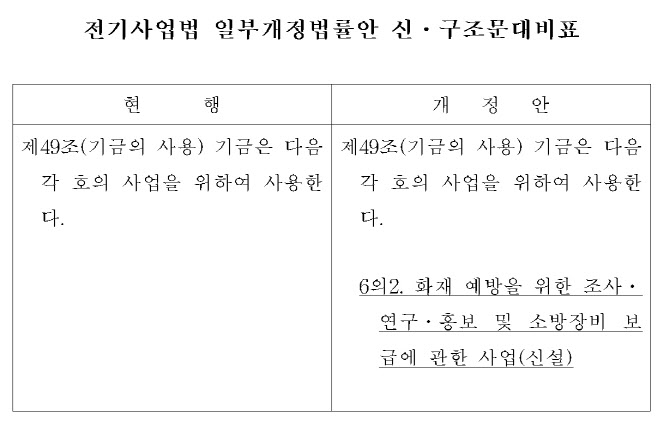As the main cause of the fire, there are concerns that the power fund created for the purpose of developing the power industry and stabilizing the supply and demand of electricity is being reduced to’blind money’ as the power fund is trying to procure the cost of supplying firefighting equipment.
The Ministry of Trade, Industry and Energy, which is the main ministry, revised the Electricity Business Act earlier this year, so that the KEPCO Institute of Technology, which is scheduled to open in March next year, can be financed from the Electric Power Fund. Even at this time, accusations of using the power fund like ssamjit money arose. As of last year, the electricity fund has accumulated 4.3 trillion won.
|
According to the National Assembly and the power generation industry on the 15th, Rep. Lee Ju-hwan (People’s Power) proposed the’Electricity Business Act Partial Amendment Bill’ so that the electric power fund could be used for fire prevention investigations, research, public relations, and firefighting equipment distribution projects.
In Article 49 of the amendment proposed this time, a new provision that the electric power fund can be used for’investigation, research and publicity for fire prevention and projects related to the supply of firefighting equipment’ was newly established. The core content of the bill is to allow the fund to be used for firefighting activities, mainly for renewable energy subsidies, power-related research and development (R&D), regional support around power plants, electricity supply support for farming and fishing villages, and electric safety management.
Rep. Lee Joo-won explained, “In order to minimize the damage caused by the fire, the revised bill was proposed to the effect that it is necessary to strengthen the social responsibility of electricity vendors and electricity users for the cost of firefighting activities.”
Since there are many fires that are caused by electricity, it is to prepare a legal basis so that money can be spent on the Electric Power Fund for prevention, investigation, and publicity. If the amendment is passed by the National Assembly, public institutions or related institutions capable of promoting, safety, investigation, and research related to electric safety or fire can use the electric power fund. This year, the budget allocated by the Fire Department for fire safety education, firefighting big data analysis, fire detection techniques development, and firefighting equipment reinforcement is about 10 billion won. In the’Fire Safety Special Measures’ announced by the government in 2018 and 2019, the relevant budget alone was about 83 billion won. Even if the related budget is simply collected, it is more than 100 billion won. It means that this money will be raised from the Electric Power Fund.
Against this, there are high voices against the power generation industry, saying that the use of the electric power fund to supply firefighting equipment for the purpose of preventing electric fires is not in line with the purpose of the fundraising in the first place. In particular, it is protesting that the politics will always try to use the electricity fund as’Samjitdon’ if the lawmaker’s legislative legislative amendments leave a precedent that creates grounds for which there was no discussion at the government level.
An official in the power generation industry said, “Even if the number of fires caused by electricity and the scale of damage are large, using the electricity fund prepared for the people’s electricity costs transfers the burden and responsibility to the people.” It will remain the worst precedent for writing like this.”
The Electric Power Fund was first launched in 2001 during the Kim Dae-jung administration. It is accumulated by charging 3.7% of the electricity bills paid by the people each month. In fact, it is a’quasi-tax’ paid by all citizens. The Ministry of Trade, Industry and Energy, which operates this, mainly uses this money to support the new and renewable energy industry, develop power supply technologies, and support projects around power plants.
Yeonje Jeong, a research fellow at the Korea Energy Economics Institute, said, “For public interest purposes, we should consider broadly the use of the power fund. As the electricity fund is financed from electricity bills paid by consumers, it is necessary to first consider promoting consumer welfare such as welfare discounts for housing. Said.
|


